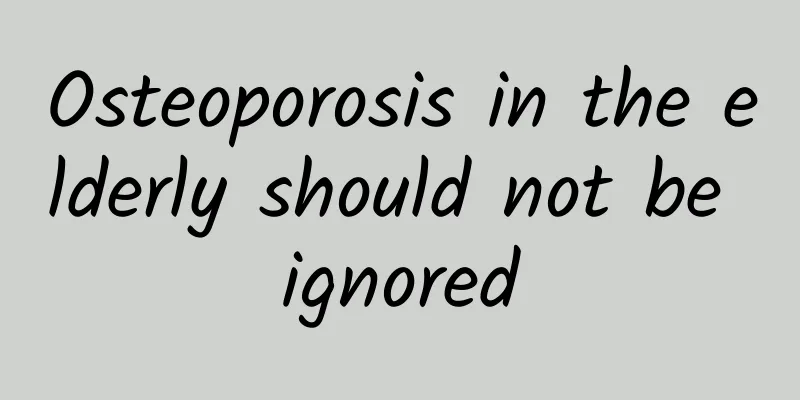Osteoporosis in the elderly should not be ignored

|
Author: Wang Changyuan, Chief Physician, Xuanwu Hospital, Capital Medical University Reviewer: He Jingyu, Chief Physician, Xuanwu Hospital, Capital Medical University my country has entered a society with an aging population. The prevalence of osteoporosis in people over 65 years old is as high as 32.0%, of which the prevalence in women is as high as 51.6% and that in men is 10.7%, which seriously affects the physical health and quality of life of the elderly. Osteoporosis is a systemic bone disease characterized by decreased bone mass and increased bone fragility due to damage to the microstructure of bone tissue. It is prone to induce fractures and has the characteristics of high prevalence, high disability rate and high treatment costs. Osteoporosis is more common in postmenopausal women and elderly men. The onset is insidious and the clinical manifestations lack specificity. In particular, elderly patients are often neglected in the early stages, making diagnosis difficult and not receiving timely treatment. They are only diagnosed and treated when fractures occur, and the best time to treat osteoporosis is often missed. Therefore, osteoporosis in the elderly cannot be ignored and should be given enough attention. Early diagnosis and early treatment will help reduce the disability rate and improve the quality of life of the elderly. Figure 1 Copyright image, no permission to reprint 1. Causes and clinical manifestations of osteoporosis in the elderly Osteoporosis is the result of multiple factors. Uncontrollable factors mainly include genetic factors, age, gender, menopause time in women, family history of osteoporosis, etc. Controllable factors include lifestyle, diseases and drugs that affect bone metabolism, etc. Unhealthy lifestyles that lead to osteoporosis include high-sodium diet, calcium deficiency in diet, high-protein or low-protein diet, alcoholism, smoking, insufficient light and aerobic exercise, etc. Diseases that affect bone metabolism include endocrine system diseases (diabetes, hyperthyroidism, hyperparathyroidism), rheumatic immune system diseases (rheumatoid arthritis, systemic lupus erythematosus, etc.), digestive system diseases, blood system diseases, chronic kidney disease, neuromuscular system diseases and tumors, etc. Glucocorticoids, heparin, proton pump inhibitors, thyroid hormones and some anti-tumor drugs are also important causes of osteoporosis. In the early stage of osteoporosis in the elderly, there is no specific manifestation, and it may only manifest as reduced mobility. Low back pain is one of the most common symptoms of osteoporosis. The pain worsens after physical activity and eases after rest. Pain may also occur in the hips and lower limbs. Short stature, spinal deformities such as scoliosis and kyphosis, and brittle fractures of the vertebrae or hips are typical manifestations of osteoporosis. Due to pain or spinal deformity, elderly patients have difficulty in moving, their ability to live independently is reduced, and they are often accompanied by emotions such as anxiety and depression. Figure 2 Copyright image, no permission to reprint 2. Diagnosis, prevention and treatment of osteoporosis in the elderly The diagnosis of osteoporosis requires a comprehensive diagnosis based on the patient's osteoporosis risk factors, symptoms, physical examination, bone density, laboratory tests, and imaging tests. Bone density tests are an important means of diagnosing osteoporosis. Patients suspected of osteoporosis should go to the hospital for treatment in a timely manner. The main treatment goal of osteoporosis in the elderly is to minimize fragility fractures and reduce fracture-related disability and mortality. The occurrence of osteoporosis in the elderly is mainly reduced by changing controllable risk factors such as lifestyle. First of all, you should have a balanced diet, low in salt, rich in calcium, and moderate in protein. The diet should be mainly high-quality protein (such as eggs, meat, and dairy products), with a daily protein intake of 0.8 to 1.2 g/kg. Eat a balanced diet of fruits, vegetables, fish, nuts, etc. Secondly, you should exercise regularly. It is recommended to do 150 to 300 minutes of moderate-intensity exercise per week, such as Tai Chi and dancing. You should proceed step by step and gradually increase the amount of exercise. All exercise is based on safety. You should prevent falls during exercise. Maintain adequate sunlight, and get more than half an hour of sunlight every day to promote the synthesis of vitamin D in the body, which is also beneficial to physical and mental health. Figure 3 Copyright image, no permission to reprint Smoking and drinking are risk factors for osteoporosis, so you should quit smoking and reduce alcohol intake. You should also reduce the intake of coffee, carbonated drinks and strong tea, and avoid using drugs that affect bone health. The basic treatment for osteoporosis is calcium and vitamin D supplementation, and drugs such as bisphosphonates for the treatment of osteoporosis must be used under the guidance of a doctor. Traditional Chinese medicine preparations such as Xianling Gubao Capsules and Qianggu Capsules have a good effect in treating osteoporosis. Figure 4 Copyright image, no permission to reprint In short, osteoporosis is a common chronic disease among the elderly. Risk factors should be intervened at an early stage, a healthy lifestyle should be promoted, bones should be maintained healthy, falls and fractures should be prevented, and sufficient attention should be paid to improve the quality of life of the elderly. References [1] “Expert consensus on establishing a three-level prevention and control system for osteoporosis in the elderly in China” writing group, Geriatric Osteoporosis Branch of the Chinese Geriatric Health Research Association, Geriatric Endocrine and Metabolism Branch of the Chinese Geriatric Health Research Association, etc. Expert consensus on establishing a three-level prevention and control system for osteoporosis in the elderly in China [J]. Chinese Journal of Internal Medicine, 2022, 61(6): 617-630. [2] Working Group of the Chinese Osteoporosis Diagnosis and Treatment Guidelines for the Elderly (2018), Osteoporosis Branch of the Chinese Society of Gerontology and Geriatrics, Ma Yuanzheng, et al. Chinese Osteoporosis Diagnosis and Treatment Guidelines for the Elderly (2018)[J]. Chinese Journal of Health Management, 2018, 12(6): 484-509. |
<<: National Hypertension Day丨Control your blood pressure and don’t let it “crush” your health!
>>: What should I eat if my uric acid level is high?
Recommend
What is the reason for car oil leakage in winter? How to solve the problem of car oil leakage in winter
Motor oil is a lubricant used in the engine. It r...
What's wrong with the little girl's back pain?
The older a normal person gets, the more diseases...
Master these key points and easily grasp the kidney's distress signal
1. Changes in urine volume The average daily urin...
How long does it usually take to get an abortion?
If a woman is pregnant and wants to have an abort...
Can I get pregnant if I have sex at the end of my period?
Each month, women's period can be divided int...
What can't you eat if you have a miscarriage?
As we all know, the body of a woman who has suffe...
Is it better to make the dough for pancakes harder or softer? What are the tips for making the dough for pancakes?
As we all know, pancakes are a common type of pas...
Will breasts get bigger when you get pregnant?
With the change of roles after pregnancy, many pr...
How many days after a normal birth can I take a shower
If possible, it is recommended that all mothers g...
What to do if your menstrual flow is light
Presumably, in life, many female friends have fel...
Can I wash my feet during confinement after a normal birth?
Pregnant women have weak systems after giving bir...
Health care for middle-aged and elderly women
When Nuwa created humans, she created men and wom...
Can eating "anti-sudden death meal" prevent sudden death? The September rumor list is freshly released
Review expert: Song Bingbing, a registered dietit...
How to take the "special medicine" when you are infected with influenza B? 10 questions and 10 answers from pharmaceutical experts
Recently, influenza (hereinafter referred to as f...
What is breast hyperplasia?
Fibrocystic breast disease is a breast disease. I...









